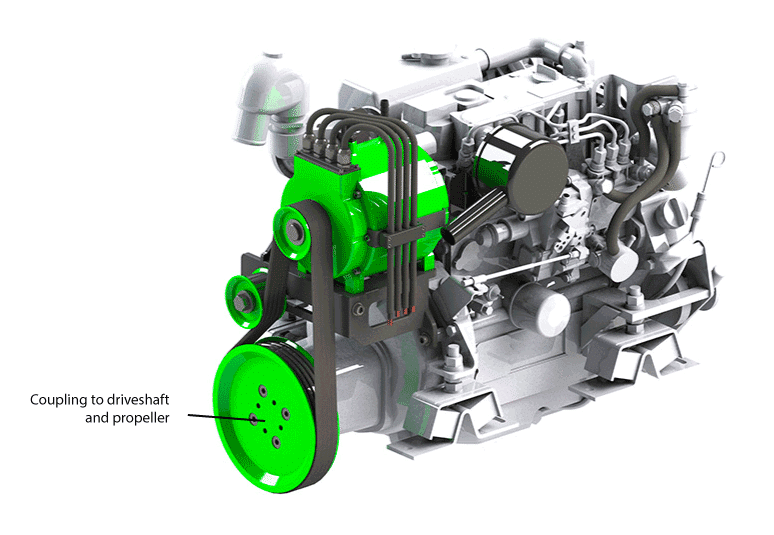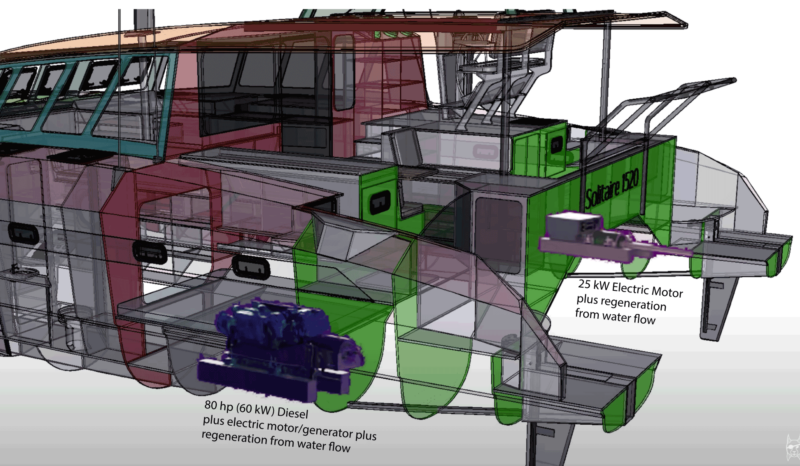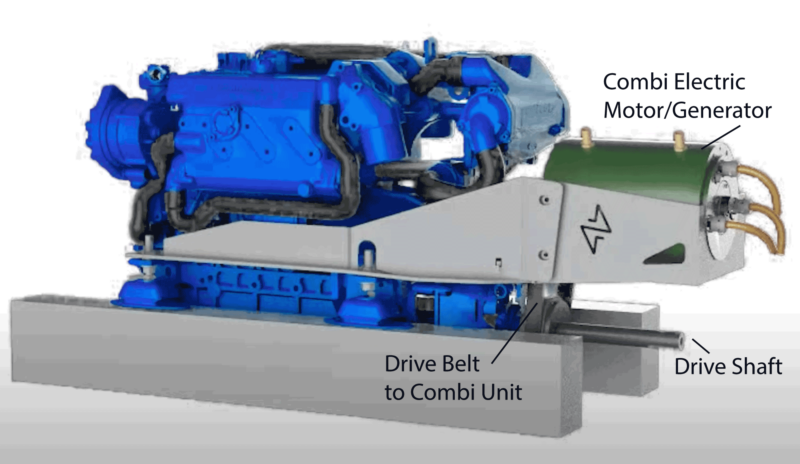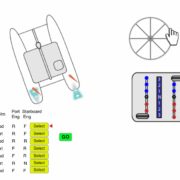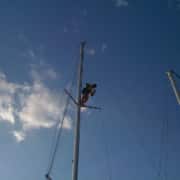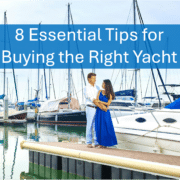Learn more about sail trim with either NauticEd’s FREE Basic Sail Trim Course for any aspiring sailor, or learn more comprehensive techniques with the Advanced Sail Trim online course.
EVERYTHING EVOLVES
Hybrid Propulsion Systems for Sailboats
Hybrid, hybrid, hybrid – the marine world is going to hybrid power. On a boat, hybrid means the symbiotic energy relationship between diesel and electric. And, boat manufacturers are scrambling to investigate the best hybrid solutions for their future boats.
This scurry to hybrid is being driven by many reasons:
- The biggest time-driving reason is that port authorities are putting future bans on diesel engines operating in their ports. For example, in 2025, boaters will no longer be able to operate a diesel or petrol engine in Amsterdam waterways. The European Green Deal describes a massive initiative for Ports of the Future.
- Rising fuel costs. A hybrid solution increases energy efficiency and thus reduces operating costs
- Reduced dependence on the need to fill up – which is a big advantage when ocean crossing and global cruising
- Can do day trips on electric only – charge batteries at the dock and operate during the day and an overnight fully on electric engines
- An abundance of available electrical energy when needed
- The feeling of being green gives us all (well most of us) a closer connection to the planet and doing our responsible part to the solution of human pollution – now that the technology is available.
- Quiet operation of air conditioning units – no generator
- Hybrid provides a redundancy solution – diesel AND electric.
- For performance boats, a hybrid solution reduces weight by eliminating the electric generator and for catamarans, the second diesel engine.
Why Hybrid Now?
What makes a diesel/electric hybrid solution available nowadays is the advent of high energy density Li-Ion batteries which allow an abundance of electrical energy to be stored and drawn upon efficiently when desired. A hybrid solution is as simple as attaching a dual-role electric motor/generator onto the drive shaft of the existing diesel engine via a belt. When the diesel engine is running, mechanical energy is delivered to the propeller as well as to the electric motor/generator where the mechanical energy is converted to electric energy and stored in the Li-Ion batteries. When desired, the diesel can be disengaged and electrical energy from the batteries can run the electric motor/generator to drive the propeller. A further innovation can allow the spinning propeller being turned by the water while the boat is under sail to regenerate that energy for storage in the batteries.
Understanding Hybrid Energy
The reason for hybrid as opposed to fully electric is that a fully electric solution for the marine world is not as easy as a Tesla on the roads. On the ocean, there is not an energy top-up station at the end of every 100th wave. While there is solar which is an important part of the energy input equation, solar can never be enough to power the drive train, run air conditioning, and run all the other electrical requirements of a boat.
The energy density of diesel continues to be a superior means of energy storage. 1 liter of diesel contains about 38 mega-joules of energy. For those of you that know me – I love the math behind it all – let’s take a quick look (warning heavy math to follow).
A joule is an amount of energy.
1 joule/second = 1 Watt – the flow rate of energy
Thus: 1 Watt.sec = 1 joule
1 Watt.hour = 3600 joules
38,000,000 joules = 10,555 Watt.hrs ~ 10 kW.hrs
1 liter of diesel = 10kW.hrs
Diesel generators run at about 40% chemical energy conversion to electrical energy or mechanical energy.
So therefore 1 liter of diesel can be converted using an efficient generator to about 4kw.hrs of energy.
1 liter weighs just under 1 kg (2.2 lbs) whereas a 4 kW.hr Li-Ion battery will weigh 30 kg (70 lbs)
An average 50 hp diesel operating at 2200 rpm (cruising speed) will consume about 4 liters per hour. For most boats, this will drive the boat at about 5 knots or 5 nautical miles in 1 hour using 4 liters. At 2200 rpm the 50hp diesel engine driving a propeller is consuming 15 kW (but note that it is capable of delivering about 25 kW @2200 rpm). In 1 hour then, the propeller consumes 15 kW.hrs.
From a solar perspective, each sq.meter of solar can produce about 1.2 kw.hrs of energy per day (sunny). Thus the energy created in 1 day on 4 sq.meters of solar is about equivalent to ( a bit more than) the energy of 1 liter or diesel and about 1/3rd of the energy used by the propeller in 1 hour. This means that solar can only run the drive train for about 20 minutes per day (on 4 sq.m) – not much!
The above demonstrates the need for diesel because of its energy density in storage tanks. But the trick to hybrid is that a diesel engine can produce more power than what the propeller takes – and adding extra load to the diesel makes the diesel engine run more fuel efficiently per kW output. At 2200 rpm, an additional 10 kW is easily available. Thus, when operating on hybrid generation mode, the excess energy is taken off in the form of electrical energy and stored in batteries.
An average Lithium-Ion battery bank will hold about 20-30 kW.hrs of energy which can be fully charged in just a few hours of engine run time (while motoring). This can be 2-3 hours of electric motoring time – more if the electric engine is run at lower speeds such as in the marina.
The average modern sailboat consumes about 5kw.hrs of energy per day just running the boat systems such as fridge, electronics, winches, autopilot etc. (not including the air conditioner). Meaning that solar can sort of keep up with boat management requirements but not drive or air conditioning requirements. This is why a traditional boat uses two diesel engines, a diesel generator to create enough electrical energy to run the air conditioning (and charge the batteries and other electrical requirements) plus a diesel engine dedicated to the drive train.
Hybrid Energy Goes More than Both Ways
The management equation changes when hybrid is introduced. What this means is that at any time:
- the main drive engine(s) can be used to generate electricity as well as simultaneously propel the boat OR
- the main drive diesel engine can be used solely to generate electricity instead of the need for a generator OR
- the main drive diesel engine gearbox can be put into neutral. The boat can then be propelled 100% electrically from stored electrical energy OR
- what is known as regeneration – the turning propeller while under sail can be used to generate electrical energy OR
- For day outings, with the batteries fully charged from the dock, the diesel engine does not need to be used at all OR
- On long passages when light winds are present and you need to turn on diesel engines to maintain passage, the batteries are automatically being charged – thus some of that daily passage can be performed on electric – about 2-3 hours running at low speeds OR
- Solar energy can be used to run the electric engine at low speeds – thus creating emergency redundancy
That’s a lot of fantastic “ORs” – all of which work to increase energy efficiency and reduce reliance on having consistent access to diesel – this is especially true when cruising the open oceans.
The Cost of Hybrid Engines in Boats
Well, most of the cost is offset from removing the diesel generator from the money equation (about $20k). The batteries are charged while motoring or sailing and with solar.
For charging while at anchor, the propulsion diesel engine can be completely disengaged from the propeller by using Combi’s magnetic clutch allowing the diesel to completely act as a generator – and efficiently too because all the energy created is going into the batteries for later and efficient use. Many times on a traditional boat, we have had to turn on the generator just to make a pot of coffee. That’s not an efficient use of a diesel engine.
A big additional advantage other than being allowed into a diesel-free port is a quiet night’s sleep where the air conditioning is running from the stored electrical energy in the batteries rather than from the noisy stinky polluting generator.
What does need to be added into the money equation is the Lithium-Ion batteries which can be quite expensive. A typical 40-foot monohull will need about 20 kW.hrs of energy stored in batteries to run a typical air conditioner through the night in Caribbean-style water and air temperatures along with other boat systems. You can halve that in cooler waters such as the Mediterranean. At $1000 per kW.hr, 20 kW.hrs of battery energy storage capacity will thus cost $20,000 – about as much as a diesel generator. But prices of Li-Ion are dropping following to Mohr’s law and within 5-10 years they are expected to be more like $200/kW.hr
Who is Supplying Hybrid Solutions?
One such company we have talked to about the hybrid solution and appears to be leading the charge in hybrid is a Dutch company called Combi Electric Propulsion Systems. Combi have about 300 hybrid sailboat installations since their introduction of their prototype in 2017. Combi are well placed to continue to be the leader in hybrids because they have extensive experience in making marine electric motors since their inception in 1979.
This very informative video was put together by SV Lynx who have built a performance Catamaran using the Combi system. They go into all the details and it is well worth the viewing time.
The Combi solution uses a 48 V bank of Li-Ion (LiFePO4) batteries which is a safe but efficient way (more so than 12 or 24 volts) to store electrical energy. These batteries are charged directly by the hybrid system. When this energy is required for boat electrical systems, a down converter simply lowers the stored supply voltage down to 12 volts. Additionally, many systems are being manufactured for direct use of 48 volts, e.g. Air conditioning units and water makers.
What is clever about the Combi hybrid system is the electronics smartly make decisions about the energy available or desired also taking into consideration the power curve of the diesel engine. This properly loads the diesel engine to a more efficient area of the power curve – almost gaining energy for free(ish) when the diesel engine is running.
An additional innovative application of the Combi is the way that they design propulsion for a catamaran. One hull has a diesel engine and hybrid electric generator/motor while the other has only an electric motor driven from electricity supplied by the hybrid system on the other hull and along with a regeneration system. This allows the Cat to be propelled in both hulls while only having one diesel engine.
The Combi hybrid solution has many advantages over a high-output alternator.
- The energy is pulled off the main drive shaft rather than an alternator pulley on the front of the engine. Thus engine manufacturers are more apt to warranty the hybrid addition as opposed to the high torque on a high-output alternator.
- The energy output can be 3 times or more than a high-output alternator. Thus less engine run time.
- Regeneration is possible.
- Fully electric operation and quiet runnnig is possible.
- Engine redundancy is possible
Hybrid Conclusion
Combi is a worthwhile solution to look at for your energy needs of the future.
Their system can be installed on new or existing sailboats. A bracket simply mounts to the aft of the existing diesel engine in which the Combi electric generator/motor is fitted. A belt runs from the prop shaft to the Combi unit which delivers and pulls energy from the Lithium-Ion battery bank.
NauticEd International Sailing Education supports a green planet!


